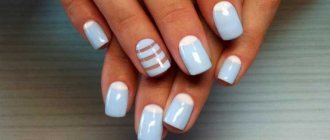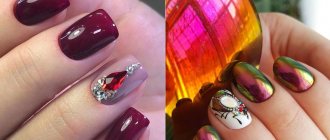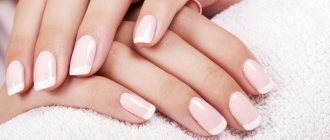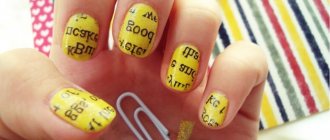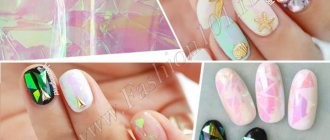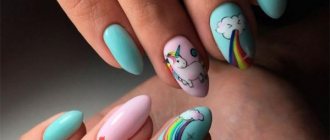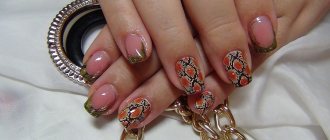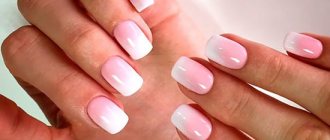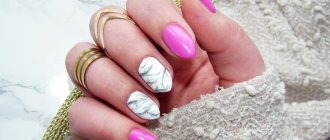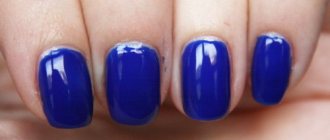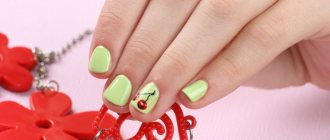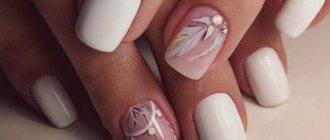What do we need
Watercolor nail design gets its name because of its similarity to the watercolor technique in painting. To verify this, just look at the photo of watercolor painting on the nails. The same shades and light semi-liquid paints are used, creating a spreading effect. However, it is worth noting that for painting the plate, it is not school paints that are used, but real artistic watercolors. It has a different composition and production format, due to which it fits better on the surface.
But not every paint can be topped with a layer of gel. This suggests that choosing the material for such a design should be done with special care.
Watercolor painting is applied to nails with special manicure brushes. They are quite thin and vary in length and thickness. For example, a brush can be not only size zero, but also size 00.
Watercolor is diluted in ordinary cold water, so achieving the desired thickness for work will not be difficult. As with drawing on paper, a palette is used to mix colors. In addition to watercolors, you can use acrylic-based paints in painting, which are also diluted with water. But when working with them, you must remember that it is impossible to remove dried acrylic from the brushes, so you should not let them dry while painting.
When replacing one brush with another, more suitable in thickness, the used brush must be washed immediately. In addition to watercolors and acrylics, some people use diluted gel polish. Since it is too thick for painting, it is diluted with topcoat or concealer.
Features of watercolor technique
Watercolor is a nail art technique used to embody design ideas. This method of decorating nails is gaining popularity among the top, leading trends from the end of the 2020 season until the 2021 autumn-winter season, including the spring-summer season. Winter watercolor is just as popular as its other varieties.
Watercolor painting is characterized by a sophisticated design: from the application of faded stains to the effect of artistic painting. The paint creates a unique composition on the nails, maintaining a balance of translucent, pastel colors. Also, watercolor can become rich and colorful if desired and necessary. Depends on the choice of design or pattern.
The base plays one of the key roles in the execution of the technique. A correctly selected base allows you to recreate a smoky, multi-dimensional spreading effect on your nails. The effect of watercolor paint can appear in a single form, creating an expressive transition in the composition of the painting. You can also decorate all or several nails with it. This will not negatively affect the overall look, but, on the contrary, will allow the manicure to shine in a creative design.
Does not require an ordinary base. Can be used on both light and dark surfaces. The main thing is that the color of the decor stands out and shines against the background of the main paint.
The coating may be sticky during application. It is necessary to handle it carefully and prudently during the procedure. For fixing, the same lamp is used as for gel polish.
How to prepare the background
Before watercolor painting appears on your nails, you need to create a kind of base using gel polish.
When creating a background, you must follow the standard instructions for applying gel polish. It will become the very sheet of paper on which you will draw your masterpiece. In this process, a UV lamp plays an indispensable role, without which the applied compositions will not dry properly.
First, a manicure is done, the cuticle is removed, the nails are shaped, and everything unnecessary is removed. Then the greasy layer is removed, followed by the base, color, and top coat, each of which is dried under a lamp. After the top layer has dried, the surface of the plate is ground, achieving a slight roughness. Now you can start manicure with watercolor paints.
Tools for watercolor design
The technique of drawing sketches, landscapes or floral motifs cannot do without the necessary assortment at all stages of preparation:
- The greatest attention is paid to the paint, its properties and quality. The durability of the manicure and the unpretentiousness of its appearance depend on the structure. It is better to buy in stores whose specialty is based on nail art products.
- The process of drawing a picture is also impossible to carry out without brushes. If we paint with watercolors, then it is worth acquiring different subtypes: thin, hard, lush, long, short. It is most convenient to purchase a set with the necessary varieties. The thickness of the brush is proportional to the amount of work on the nail plate.
- Foil, paper, and a container of water may also come in handy during the work. When mixing and washing out shades, it’s almost impossible to do without them. You should ensure their availability in advance.
Important: during the entire procedure, the manicure brush must be kept wet. Otherwise, applying paint will be much more difficult.
The whole process can take quite some time. If it is complicated by additional decorations, such as sparkles, rhinestones, rubbing or other techniques, then the work time is extended even more. You should not forget about this by planning your hours in advance.
Watercolor manicure technique
Watercolor painting on nails step by step is not as difficult as it might seem. Of course, the ability to draw is a big plus. But beginners are not recommended to take on too complex design options. If you are just starting to master painting on nails with watercolors, start with the simplest thing - try to draw dots, stripe patterns, a flower, some simple shapes.
Drawings on nails with watercolors are done step by step as follows:
- After the base has dried, apply the required amount of watercolor to the brush.
- Apply the outline of the future design with the thinnest brush and wait until it dries.
- Now you can apply the main colors. Be sure to wait for the outline and each individual color to dry so that the paints do not end up mixing.
- Experiment with different formats, see what effect different angles of the brush and pressure will give.
- If the image is planned using dark colors, the main background should be white. If the colors are light, then vice versa. Take a look at the photos to see the difference.
- The finished drawing must be secured with a layer of transparent varnish.
Now that you know how to paint on your nails with watercolors, you can start creating your own masterpieces. Stencil watercolor on nails can be a great help for beginning artists.
Techniques for painting nails with watercolors
To make your manicure look great on your hands, you need to master the right techniques to create a watercolor design. These include:
- Washing.
Thanks to this technique, you can create bright, colorful flowers. A pastel shade is applied to the nails, which must be heavily diluted with water. After the first layer has dried, apply the second and third. This will make the midtones deeper. Attention! There is no need to apply a fourth coat. - Raw. A smear is carefully applied to the still wet layer of varnish, which can be done several times. The main thing is to notice those very smooth transitions for which such a manicure was created. If you need to enhance the color in some places, you should also use a brush on a “wet” layer.
- Monochrome range. In any situation, designs made in one color look advantageous on nails. This kind of work is easy and quick to do, and the results will please you for a long time. First you need to draw the contours and leave them for a while to dry. Next, you need to moisten the brush in water and fill the gaps inside. At the end of the work, draw the contours again to give clarity. Abstract drawings look good using this technique.
- Stained glass. The principle of performing the technique is very similar to the one mentioned above. The key difference is that it is difficult to imitate stained glass, which in some works requires mica and the use of a palette of paints.
- Watercolor gel polishes on French nails. A typical French manicure, already loved by fashionistas, has been reworked by masters: now it is used as a canvas for watercolors. In addition, the result is very interesting.
- White watercolor strokes. To perform this technique you will need a flat brush and watercolor white. Apply a little white paint to the edge of the nail. You can also use a medium-thick brush and, making small strokes, change the background of the picture.
- Blurring with a flat brush. You can complement your floral design using the amazing property of watercolor that it blurs even with a small amount of water. To do this, you need to take the desired shade and blend it with a brush. In this way, a color change can be achieved.
- Double stroke technique. Perfect for drawing voluminous colors that combine several shades. The execution process is very simple: 2 colors are applied to the brush, not mixed with each other. And with each contact with the nail, a double stroke is obtained, consisting of several highlights at once.
Master class on watercolor paintings on nails
Liner is one of the means of drawing watercolor techniques on nails, allowing you to draw small details of the design. With its help it is very convenient to depict animals, faces and landscapes.
To create a design using a liner you will need:
- base coat;
- varnishes of burgundy, silver and pink colors;
- liner;
- small rhinestones;
- fixer
First, a base is applied to the nail to level the surface of the plate. After it dries, cover it with pink varnish in 2 layers. Then, from the upper left corner, draw 2 parallel burgundy lines - one thicker, the second thinner. Now the same stripes are drawn from the right corner. Add a silver line and a fixative, and apply rhinestones using a toothpick. A wonderful manicure is ready!
Step-by-step photo of watercolor manicure with gel polishes
How to paint three-dimensional flowers on nails with watercolors step by step
As practice shows, drawings on nails with watercolors made on a white background are more expressive. Therefore, for voluminous flowers, it is worth preparing your nails by applying a light canvas varnish for painting. Then follow these steps:
- Using a thin brush, pick up a crimson shade and paint a single floral element. Precision is not needed, you need to act quickly and carefully.
- It is worth creating the effect of a “tattered” pattern, as if the image continues behind the extension of the nail on the hand.
- Using a green tint, add leaves to the flower. Moreover, it is better to sharpen the tip of the sheet to give it a natural look.
- To create a relief for the design, apply black color in the center of each flower.
- Next, continue to highlight the outline of the petals.
- Cover with clear sealing varnish.
Manicure using stained glass watercolor technique
What variations of painting with watercolors exist?
- One-color painting. An interesting technique in which craftsmen experiment with different shades of the same color. It looks no less attractive than different colors.
- With the addition of acrylic paints. In nail design, acrylic is often used in addition to watercolor. With its help you can make a beautiful emphasis on certain details of the drawing.
- With the addition of colored gel polish. Both of these materials are very similar to each other, and the combination of varnish and paints gives the finished picture depth and brightness, as on ordinary canvases. Experienced manicurists in Moscow, who have mastered the technique to perfection, have learned to create truly amazing works.
- With added accessories. Nails can be further decorated with foil, rhinestones and other inserts.
- Through a stencil. The use of stencils with an adhesive base is suitable for beginners and will help hone the technique of step-by-step paint application.
Whatever you choose, a high-quality design with watercolor paints on your nails will look luxurious in any case.
Watercolor manicure with flowers
Flowers are the most common nail design option using watercolor technique. In order for the floral image to have a more neat and beautiful appearance, it is worth paying tribute to the finished pictures. This will provide a unique opportunity to monitor the correct application of specific ornaments and colorful shades. Watercolor paints provide a unique chance to obtain the desired color range by mixing and diluting paints. Thus, the desired floral design does not require multi-layer applications. You just need to approach the shades correctly and apply them as carefully as possible.
What do the professionals advise?
Masters of watercolor nail art give useful tips that will be useful to beginners:
- The base should be matte. The watercolor technique of painting nails does not accept gloss.
- It is advisable to use a base color, if not white, then in light tones. Dark colors will not convey the beauty of the design so well. The exception is the design in pastel colors.
- If you need to “edit” a drawing, you need to take a semi-dry brush and remove the excess.
- For more successful training, it will be useful to use video lessons from experienced manicurists. It will also be useful to find step-by-step photos of watercolor manicure on nails.
Sealing or securing
The final stages play a significant role in the final look of the manicure. They should be given no less attention than composing the composition.
Tips for consolidation that may be useful at the end of all stages:
- To seal, you can use a two-in-one top or a regular rubber top.
- If you used rubber, you will have to reapply a regular gel polish topcoat. This will maintain the durability of the coating and healthy shine.
- A top with a two-in-one effect does not require re-coating.
- Do not forget about removing the dispersion layer after drying in the lamp.
